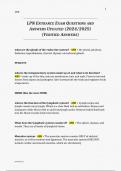1
LPN
LPN ENTRANCE EXAM QUESTIONS AND
ANSWERS UPDATED (2024/2025)
(VERIFIED ANSWERS)
what are the glands of the endocrine system? - ANS ✓the pineal, pituitary,
thalamus, hypothalamus, thyroid, thymus, and adrenal glands.
PPHATTT
what is the integumentary system made up of, and what is its function? -
ANS ✓made up of the skin, mucous membranes, hair, and nails. Protects internal
tissues from injury and pathogens. Also waterproofs the body and regulates body
temperature.
HNMS (like the store H&M)
what is the function of the lymphatic system? - ANS ✓Lymph nodes and
lymph vessels carry lymph, Which is a clear fluid rich in antibodies. Houses and
transports white blood cells to and from lymph nodes. Returns leaked fluid back
into the blood vessels (back into blood).
What does the lymphatic system consist of? - ANS ✓The spleen, thymus, and
tonsils. They are all made of lymphoid tissue.
Muscular system - ANS ✓The muscular system consists ONLY of skeletal
muscles, as well as tendons and ligaments. The muscular system DOES NOT
include cardiac and smooth muscles, which are involuntary
LPN Entrance
, 2
LPN
What parts does the nervous system consist of, and what is its function? -
ANS ✓The nervous system consists of the brain, spinal cord, and nerves. It is the
body's control system. Sensory receptors detect stimuli that can occur both
inside and outside the body.
What does the reproductive system consist of? - ANS ✓Testes, penis, ovaries,
vagina, and breasts. These organs house hormones that encourage or suppress
activities within the body, and they also influence the development of the body.
What is the function of the respiratory system? - ANS ✓The respiratory
system keeps the body's cells supplied with oxygen, and it removes CO2 as it is
released from cells. Alveoli are tiny air sacks in the lungs through which oxygen
and CO2 move in and out of via small blood vessels called arterioles.
What are arterioles? - ANS ✓Arterioles are small blood vessels found in the
walls of alveoli which are found in the lungs. Oxygen and CO2 move in and out of
these small blood vessels.
What does the respiratory system consist of? - ANS ✓Nasal cavity, pharynx,
larynx, trachea, bronchi, and the lungs.
What does the skeletal system consists of, and what is its function? - ANS
✓The skeletal system consists of bones, cartilage, ligaments, and joints. It
provides support and protection, and a framework that creates movements (with
the help of muscles).
What is the function of the urinary system? - ANS ✓The urinary system helps
maintain the water/electrolyte balance within the body. It also regulates the
acid-base balance of the blood, and removes all nitrogen-containing waste from
the body.
Where does nitrogen-containing waste in the body come from? - ANS
✓Nitrogen-containing wastes are by-products of the breakdown of proteins and
nucleic acids
LPN Entrance
, 3
LPN
Anatomical position - medial - ANS ✓Toward the middle of the body/structure
Anatomical position - lateral - ANS ✓Toward the outer sides of the
body/structure
Anatomical position - Intermediate - ANS ✓Between medial and lateral
Proximal - ANS ✓Close to the origin of the body part/point of attachment
distal - ANS ✓Away from the origin or point of attachment
Sagittal section - ANS ✓a longitudinal cut (up and down)
Transverse section - ANS ✓Cross-section (side to side)
Frontal section - ANS ✓Divides body into front and back regions. Also called a
coronal section
Dorsal body cavity - ANS ✓Cranial cavity and spinal column
As a function of the human body, what is regulation? - ANS ✓Hormonal
control of body functions via the endocrine system
As a function of the human body, what is oxygenation? - ANS ✓Taking in
oxygen and expelling CO2 via the respiratory system
How do arteries, veins, and capillaries function together in the circulatory
system? - ANS ✓Arteries transport blood away from the heart and to the
capillaries, and the capillaries transport that blood to the veins, which takes the
blood back to the heart.
LPN Entrance
, 4
LPN
capillaries - ANS ✓Connects arteries to veins. The capillaries is the location for
the exchange of oxygen and CO2.
What are the four chambers of the heart? - ANS ✓The four chambers are the
right and left ATRIUMS, and the right and left VENTRICLES
What are the four valves in the heart? - ANS ✓The tricuspid and pulmonary
valves on the right side, and the mitral and aortic valves on the left side.
Pathway of blood through the heart - ANS ✓First, deoxygenated blood enters
the heart through the superior and inferior vena cava. It enters the RIGHT
ATRIUM, through the tricuspid valve, into the right ventricle, through the
pulmonary valve, into the pulmonary artery, after which it goes to the lungs.
After the blood picks up oxygen from the lungs, the blood goes through the
pulmonary veins into the left atrium, then through the mitral valve, into the left
ventricle, through the aortic valve, into the aorta, then out to the entire body.
The pathway of air in the respiratory system - ANS ✓The air enters the nose,
goes into the trachea, then into the right and left bronchial tubes (which are lined
with cilia), into the alveoli, where it picks up oxygen
What are the two systems the nervous system is made up of? - ANS ✓1. CNS
= Brain and spinal cord
2. PNS = nerves that extend from the spine
The PNS is further made up of what two nervous systems? - ANS ✓1. the
autonomic nervous system
2. The sensory-somatic nervous system
PNS - the autonomic nervous system - ANS ✓An INVOLUNTARY system.
Controls automatic body functions, like heartbeat and digestion. Includes the
SYMPATHETIC nerves, and the PARASYMPATHETIC nerves.
LPN Entrance




